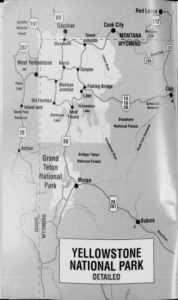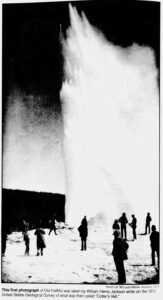150 years ago, in March 1872, a sprawling volcanic plateau filled with colorful acid pools, gurgling mud springs, and soaring geysers became the United States’ first national park. In the years since, Yellowstone’s visitors have grown from a trickle of intrepid adventurers to a steady stream of millions, all flocking to Wyoming’s northwest corner to admire the unique and otherworldly beauty of this rugged landscape.
Long before Yellowstone became nationally recognized, prehistoric peoples left their mark on the area. Artifacts dating back 10,000 years have been excavated from the lake shores, proof that the famed explorers whose names have been linked with Yellowstone since the 1800s were not the first to truly discover the region. Native American tribes and their ancestors—the Shoshone, Crow, and Nez Percé, among others—traveled, hunted, and traded in the region for thousands of years.
In 1807, explorer John Colter, previously part of the Lewis and Clark Expedition, became the first known American of European descent to see Yellowstone. But it would be another 60 years before proposals to protect Yellowstone’s unique landscape by law would motivate a series of well-funded expeditions in the area.
The Washburn-Langford-Doane expedition in 1870, followed by the Ferdinand Hayden expeditions in 1871 and 1872, completed thorough surveys of the region. Hayden’s survey reports, including paintings by Thomas Moran and photographs by William Henry Jackson that captured Yellowstone’s compelling geographical features, were key in convincing Congress to make the land a protected national park.
Newspapers at the time came alive with chatter about the region’s unusual features. The Hartford Courant published an extract of Capt. John W. Barlow’s official report, which included stirring descriptions such as “…five streams of boiling water, in porcelain channels of vermillion, rippled over cascades worn in the terrace formation of the rock,” and “the lace-maker might here find designs for his most exquisite fabrics in the delicate tracery found around the edges of numerous pools of hot water.” Imaginations were stirred by descriptions of the natural hot springs, some vibrantly colorful. The majestic heights of the geyser eruptions, including those of the famously dependable Old Faithful, were frequently shared to set the scene for readers at home.
One article, published in February 1872, described the soon-to-be national park with great confidence in this way:
Should the whole surface of the earth be gleaned, another spot of equal dimensions could not be found that contains on such a magnificent scale one-half of the attractions here grouped together.
That same year, cognizant of the need for preservation (and the potential for tourism), the U.S. Congress wrote up a bill to set the land aside “for the benefit and enjoyment of the people.” President Ulysses S. Grant passed and signed that bill into law on March 1, 1872, making Yellowstone the first U.S. National Park.
Find more on the history of Yellowstone National Park and its rocky path to becoming a tourist destination with a search on Newspapers.com™ today.
Like this post? Try one of these!




I think we should give it back to the indigenous people that “owned” it before we “stole” it. Mi tse a-da-zi, or Yellow Rock River.
The Dawes Act and the fact that Original Native Americans were separated by skin color, with the darker considered Africans and sold off and everyone all mixed together ♀️♀️
Perhaps you can do some true historical reading about what Native Americans went thru when their country was taken over and pushed into deserts (known as reservations) for our betterment.
I am 71 years, and have enjoyed all the best of the things you mentioned. Admittedly, I never realized the impact of how ruthlessly the “Indians” were treated and did not understand it until I had reasons to delve into the history of the USA. I think you would be amazed exactly where this progress you mentioned came from!! What would you like for us to “get over” ? I have never been without heating or cooling in my home or food……………I have an appreciation from where it came due a heartbreaking history that provided it. No one ever said to not appreciate or enjoy our USA….education about from where our country came from makes us appreciate our “Native Americans” even more! The have not asked for their country back……………..but just what they had to sacrifice in their lives for us to have “progress” means to understand the our “progress” has come from many people and many countries. Best wishes for your understanding thru reading.
YES YES YOU just can not go to any country and steal there land.
Try to go to china and take there land see what happens ??
Yes Miles SO TRUE
They didnt own it to start with. Land was free. It was just there. The National Park was the best Idea. Kyle L.
NEW MEXICO
Was that also free land for the taking
Is france free??
My grandmother’s single sisters traveled to Yellowstone after World War I. It was the first time my mother had seen women in ‘trousers’. The sisters had purchased them for the trip, but it was quite the scandal for the family. (The family lived near Kansas City, Missouri.)
A story including this information would enhance these peoples’ biographies and make your family genealogy much more interesting than simple names and dates. If any photos were available, thy would REALLY set it off!